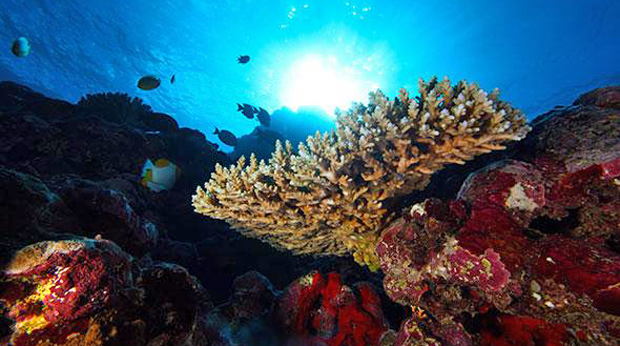

On February 16, the National Oceanic and Atmospheric Administration Ship Okeanos Explorer will begin its 2017 American Samoa Expedition to explore unknown and poorly known deepwater areas of American Samoa and Samoa, with an emphasis on Rose Atoll Marine National Monument, National Marine Sanctuary of American Samoa and National Park of American Samoa.
The expedition is part of the Campaign to Address Pacific monument Science, Technology and Ocean NEeds (CAPSTONE), a major three-year effort to systematically collect information to support science and management needs within and around the U.S. marine national monuments and NOAA’s national marine sanctuaries in the Pacific. Chris Kelley, associate professor of oceanography at the University of Hawaiʻi at Mānoa School of Ocean and Earth Science and Technology (SOEST), is the science lead for CAPSTONE.
Using the Deep Discoverer ROV, scientists will investigate deepwater habitats, geology, and the biology of sea animals as it dives as far as 3.7 miles (6,000 meters) deep. Educators, students and the general public will also be able to follow along and watch this expedition unfold in real-time via live feeds of ROV dives on the internet.
- More on Okeanos Explorer expeditions:
Explore ocean depths with live feed from expedition, August 12, 2015
Explore world’s deepest ocean trench with live feed from expedition, June 16, 2016

Exploring Samoa’s volcanic hotspot
Data and information from this expedition will fill gaps in knowledge about deep-sea habitats in the region and improve overall understanding of the deep-sea biogeography of the Central Pacific. American Samoa lies at the boundary between major biogeographic provinces making it a key area to understanding the biodiversity transitions that occur in the deep Pacific Ocean.
Much also remains to be learned about the geology around the Samoan region. The Samoa islands and seamounts result from an age-progressive volcanic hotspot, however, it is still not understood how a Samoan volcano evolves over time. This expedition will sample various volcanoes at different stages in their development, including the young active volcano, Vailulu'u, and the older Samoan volcanic feature that defines the island of Tutuila.
Command center on UH Mānoa campus
In the Hawaiʻi Institute of Geophysics Building at UH Mānoa, NOAA and SOEST established an Exploration Command Center—a location where live video feeds from the ship and ROVs are displayed and scientists on land can communicate with the ship-board team, enabling tele-presence collaboration.
The NOAA website for the 2017 American Samoa Expedition provides content essays filled with background information on the region being explored, a mission plan, an Explorations for Educators webpage that includes a short piece on why we are exploring this region, standards-based lessons, videos, topical theme pages and more.
—By Marcie Grabowski

